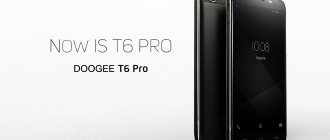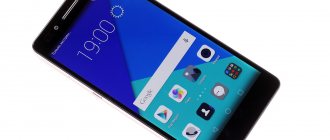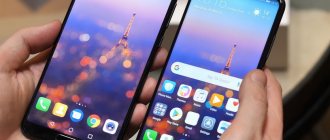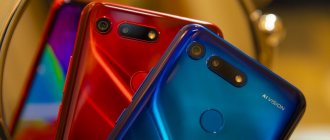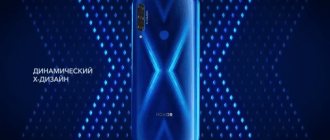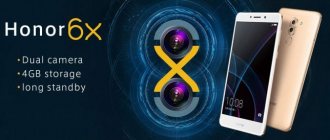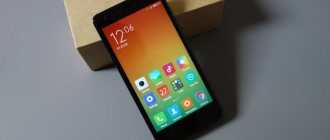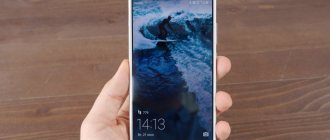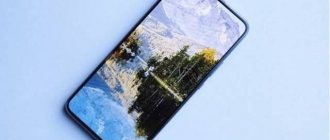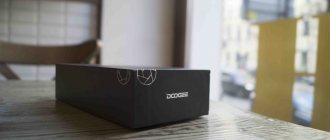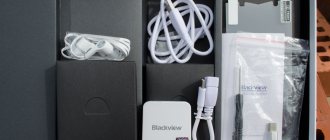Price and main characteristics
Ulefone Power 3 comes in a single version with 4/64 GB of memory. The average price of a smartphone is about $250.
Technical characteristics: • display: 6”, IPS FullHD+ 2160*1080 px (401 ppi); • processor: Mediatek Helio P23 (2.0 GHz) + video accelerator ARM Mali-G71 MP2; • RAM: 6 GB; • internal memory: 64 GB + micro SDXC flash cards up to 256 GB; • camera: main – dual 19+5 MP module, front – dual 13+5 MP module; • communication: Wi-Fi 802.11 a/b/g/n/ac, Bluetooth 4.1, GPS, A-GPS, GLONASS, LTE; • battery: 6080 mAh; • dimensions: 159.2 x 75.9 x 9.85 mm; • weight: 210 g.
The Power line specializes in large batteries; this particular phone has a 6080 mAh battery. The gadget also has an impressive supply of RAM and four cameras.
Ulefone Power 3 - review of a modern smartphone with a large battery
We live in quite an interesting time, when even small Chinese brands, following the flagships, offer a huge full-screen display with an aspect ratio of 18 to 9 and unlocking not only with a fingerprint scanner, but also with a face. What else? Six gigabytes of RAM in a device with a price tag of about $250. Frankly speaking, I have exactly the same amount of RAM installed in my laptop, on which I do video rendering. Well, for starters, an impressive battery that will allow you to forget about the outlet for 3-4 days. Interesting? For me, this is even more interesting than the latest presentation from SAMSUNG. Today we are talking about a new smartphone with a large battery from a growing brand: Ulefone Power 3 .
Characteristics
- System: Android 7.1
- Processor: 64Bit Mediatek P23 (MTK6763), 8 cores (8 x 2.0 GHz)
- Graphics: Mali-G71 MP2
- Memory: 6GB RAM, 64GB ROM
- SIM cards: hybrid slot NanoSIM + NanoSIM / MicroSD
- Screen: 6.0″ 18:9 2.5D IPS with 2K+ resolution (2160 x 1080), multi-touch 10 touches, 90.8%
- Screen coating: Corning Gorilla Glass 4
- Front cameras: 8 MP f/2.4 aperture (SW 13 MP) + 2 MP (SW 5 MP) (dual)
- Main camera: 16 MP f/2.0 aperture (SW 21 MP) + 2 MP (SW 5 MP) (dual)
- Wi-Fi: 2.4GHz/5GHz 802.11 a/b/g/n
- Battery: 6080mAh
- Bluetooth: 4.1
- Mobile communications: 2G, 3G, 4G
- Navigation: GPS, A-GPS, GLONASS, Gyro
- Sound: amplifier AW8736
- Dimensions: 159.0 x 75.9 x 9.9 mm, weight - 210 grams
- Additionally: FM radio, fingerprint scanner.
Video version of the review
Equipment/Audio Features
The device arrives in a nondescript black cardboard box with the main characteristics on the back.
When opened, we find an instruction manual, a warranty card in English, a film and a paper clip for opening the SIM card tray.
Initially, a film is already glued to the screen, but the main characteristics are duplicated on it and it is almost impossible to use it. Therefore, we have only 2 options: stick the film from the kit or use the smartphone “as is”. As usual, I recommend abandoning the film, since in this case we significantly lose in tactile perception, and the manufacturer announced a very serious screen coating: Corning Gorilla Glass 4.
Let's look further. And besides the usual USB Type C cable and fast charging at 5 volts 3 amps, we find a bunch of other useful things. For example, an adapter from MicroUSB to USB Type C will give a second life to your old cable and use it with a new smartphone, thereby saving you money. Yes, such an adapter can be ordered from Ali for a “hat of crackers” and I did this a long time ago, but they send it without tracking and it took 3 whole months to reach me, but here “all at once” is convenient!
Using an OTG adapter, you can connect a USB DAC and enjoy high-quality sound, or an external hard drive and transfer an archive of your photos and videos to it, thereby freeing up space on the device. But most importantly, since the Power line is equipped with a very impressive battery, it would be a great idea to share the charge with the device of your girlfriend or best friend, especially if they have an Apple phone, the batteries of which can only cause a smile of sympathy.
Well, since the OTG adapter is included in the kit, the interface is naturally supported. Moreover, unlike Xiaomi devices, Ulefone Power 3 can work with any external media without prior formatting.
Discovering the next adapter caused me rather disappointment. I think you already guessed, we are talking about a 3.5 mm adapter, which indicates the absence of this connector on the smartphone itself.
But what pleased me was that the headphones connected to this jack work with the built-in radio as an antenna. Personally, this tells me that the adapter itself does not contain an audio codec, and the analog signal is transmitted directly via Type C.
Speaking about the sound in the headphones, I first of all want to praise the developers for the built-in amplifier AW8736 , the volume reserve is really excellent. However, according to the measurements, I got frankly bad results. And although it is quite difficult to hear noise on podcasts or music from VK, in terms of audio capabilities this device is more likely for those who care about how the device “yells” and does not care how it “plays”.
The last item of equipment I would like to highlight is the dotted silicone bumper. Of course, it is of little use; the only usefulness I found in it was compensation for the protrusion under the camera. And so, an ordinary bumper that can be used outdoors or during repairs.
But the most important thing about the package is that you don’t need to buy anything separately: you unpack the box and immediately get everything you might need. And for this, of course, huge “respect” to Ulefone.
Design/Ergonomics
Thanks to the elongation of the screen, the device fits in your hand like a native one. The assembly is excellent, the only thing that causes confusion is the materials on the back. I’m still wondering what it is, but thanks to the shiny decorative antennas, I’m inclined to believe that the body is plastic.
The top end of the device is completely empty.
On the bottom we find a Type C port, screws for disassembly, a main speaker, a microphone and an equally decorative perforation for a stereo. The speaker sounds very juicy, with a good depiction of the lower part of the mid-range and even the beginnings of low frequencies, however, the volume could be higher, although this can be easily solved from the engineering menu. Yes, Mediatek has its undeniable advantages.
The hybrid SIM card slot is located on the left side of the device. The tray is made of metal, made flush and allows you to install 2 slots or 1 slot and a MicroSD card.
On the right, right under the thumb, there is a volume rocker and a corrugated power button, double-clicking which calls up the camera, unless of course you have an additional lock installed.
On the back there is a dual LED flash, for some reason of the same color temperature, and a slightly protruding block with two cameras and a fingerprint scanner.
The scanner operates with enviable accuracy, but at the same time has a delay of about one second. The smartphone also features face unlock, which is popular today.
Surprisingly, the device recognizes me at arm's length and even wearing a hat, but it feels like it works using cameras. That is, the lock can easily be deceived by a photograph, and even in poor lighting, the accuracy of the responses drops sharply. However, I was pleased that in Ulefone Power 3 you can simultaneously enable scanner and face unlocking. That is, if your face is not recognized, then you can easily use a finger scanner. This is of course not yet a hybrid unlock, like SAMSUNG, but it is already more than that of competitors.
The front part pleases with a 6-inch display, which occupies almost 91% of its surface. A good oleophobic coating is applied to the screen, and the glass coating is stated as Corning Gorilla Glass 4. For those who are overly careful, a film is included in the kit. The buttons are, of course, on-screen, but their sequence and the ability to hide can be configured in a special menu.
Personally, I am very pleased with the thin frames, small indents at the top and bottom, and the loud speaker, but the need for two front cameras and a flash is very doubtful.
The idea of placing a tiny indicator LED is equally incomprehensible.
Battery and autonomy
Ulefone Power 3 has a battery with a declared capacity of 6080mAh. I took 2 measurements with a USB tester and in both cases I got a result of about 6000mAh.
And in order not to spend a lot of time on charging, the device was equipped with a 5 volt 3 ampere unit.
Many people know that battery capacity is not as critical as autonomy itself, but here everything is just great: you will have to charge the device once every 3-4 days with average use. The smartphone played FullHD video at maximum brightness for more than 24 hours and this is an absolute record among the smartphones that I tested. You can play for just under 9 hours, which is also a very impressive value. And for those who need to maximize operating time, the settings provide an energy saving mode.
Display
The advantages of the display have already been mentioned several times in the review, and it is no coincidence that the screen here is really worth a lot. The device has a 6-inch display with FullHD+ resolution (2160 x 1080) and multi-touch for 10 touches, as well as an aspect ratio of 18 to 9 and support for modern technologies such as 2.5D, IPS and OGS.
In addition, I would like to pay attention to rich contrasting colors, a good brightness threshold, support for fine-tuning MiraVision and, of course, maximum viewing angles.
Interface
Looking at the advertising brochures, you will notice that they promise us the latest Android 8.1, although today the device runs on almost pure Android 7.1.1. Perhaps this is a foundation for the future, but in a month of use I have not received a single update.
Among the important points: there is customization of navigation buttons, split screen and the ability to disable system applications.
Naturally, right out of the box comes the Russian language and all Google services, as well as many different smart gestures that have long become irrelevant.
For some, the ability to record radio broadcasts, configure the indicator LED, and have a built-in QR scanner may be important.
As for the shortcomings, here I can highlight the advanced screenshot function. Yes, some will note this functionality, on the contrary, as a plus, but for me it turned out to be inconvenient: the screenshot is taken slowly, requires additional confirmation, and the snapshot itself takes place only after confirmation, which is why the moment may already be missed.
Connection
With Ulefone Power 3, everything is simply excellent: it has all the necessary 4G bands, dual-band Wi-Fi, an electronic compass, a gyroscope and, of course, navigation with support for GPS and GLONASS satellites.
Wi-Fi works at the maximum speed for my Internet.
And GPS catches 16 satellites in a matter of seconds.
Iron
Now let's move on to the controversial aspects of the device. The heart of Ulefone Power 3 is a 64-bit 8-core Mediatek P23 (MTK6763) processor, with a maximum frequency of up to 2.0 GHz. The graphics are handled by the dual-core Mali-G71 MP2. For details, consider the readings of the CPU-Z program:
And the memory modules are almost flagship: 6GB. RAM with a speed of 5500 MB/s and 64GB. ROM - 149 MB/s read and 207 MB/s write. For those who think that overpaying for 6 gigabytes is clearly unnecessary, there is a stripped-down version especially for them: Power 3s with 4 gigabytes of RAM. I did not find any other differences in these models.
Measurements at maximum graphics and CPU load showed slight throttling, but it is within acceptable limits. At the same time, no significant heating of the case was observed.
Antutu on the latest version shows about 76,000 points, GeekBench on the current firmware simply does not work.
Results of other benchmarks.
Despite a decent number of knocked out points, in real work the processor is much inferior to those from SnapDragon. You can see this on the maximum settings of the World of Tanks Blitz game, where the frame rate regularly drops to an unplayable 18 FPS.
For other games, the drop in FPS is imperceptible, but for “heavy” games it is still better to choose medium or low graphics quality.
Cameras
The Ulefone Power 3 camera interface has been greatly redesigned compared to what we are used to seeing on the “Chinese”. The advantages include changing exposure by tap, HDR and PRO modes for photos, monochrome images and a “beautiful face”. The shooting speed in normal mode is instantaneous; in HDR and blur mode there is a slight pause.
First of all, I want to dispel myths about megapixels. On the box and in advertising brochures we see the characteristics of 21 + 5 megapixels. for the main one and 13 + 5 MP. for the front camera - and this, of course, is not entirely true. These values are the result of interpolation, that is, digital magnification. In reality, we have 8+2 megapixels. front camera and 16 + 2 MP. the main one from SAMSUNG.
Interpolation is certainly not a very pleasant move, but what is most disappointing is the photos themselves. Photos taken with both the front and main cameras turn out somewhat blurry.
Moreover, if you press the 2x button, which is essentially a digital zoom, the picture turns out surprisingly much better. Therefore, I assume there is a software problem with focusing.
HDR fulfills its functionality, the difference is really visible.
There are no questions about the quality of text shooting.
Under artificial lighting - also within normal limits.
The background blur that is fashionable today works much better than on its competitors, but it is still much inferior to the flagships and, in my opinion, is still useless.
I can more or less praise the camera only for pictures taken in poor lighting conditions. The photo below was generally taken in the dark and, in my opinion, did a good job of extracting information from the partially lit unfinished house.
The device shoots video in the outdated 3GP format and FullHD 30 FPS resolution, the quality is normal.
conclusions
To summarize, let's look at the main pros and cons of the device.
I would consider the advantages:
- Fast memory: 6GB RAM and 64GB ROM
- Face and fingerprint recognition
- Loud sound in headphones
- Excellent 6″ screen 18:9 2.5D IPS with FullHD+ resolution
- Screen coating: Corning Gorilla Glass 4
- Rich equipment
- Dual-band Wi-Fi
- Battery: 6080mAh
- GPS, gyroscope, compass
- Support for all necessary bands
Minuses:
- Android 7
- Dirty sound in headphones
- No 3.5mm. connector
- Cameras with interpolation
- Weak graphics
- Blurred photos
As a result, we have a good modern smartphone with an excellent screen, flagship memory performance, a great 6080mAh battery and excellent autonomy, but the rake is still the same - problems with the camera software. For those who are primarily interested in long operating time and a high-quality display, Ulefone Power 3 will definitely be a good choice, however, the current version of the firmware will allow you to take pictures of an exclusively “technical” level.
CHECK OUT THE CURRENT PRICE FOR ULEFONE POWER 3 CHECK CURRENT PRICE FOR ULEFONE POWER 3S
Screen
Ulefone Power 3 has a 6-inch display with FullHD+ resolution and an IPS matrix. The screen has an aspect ratio of 18:9, i.e. belongs to the wide-format segment. Pixel density is 401 units per inch. Multi-touch supports up to ten simultaneous touches. The touch panel of the gadget is protected by tempered glass Corning Gorilla Glass 4. Additional protection of the screen from scratches can be provided by the film included in the kit.
The maximum brightness level is fixed at 420 cd/m2, the smartphone does not glare much in direct sunlight. The contrast level is also good, color rendition is calibrated within normal limits. The Ulefone Power 3 screen has wide viewing angles, but the quality of the sensor itself leaves much to be desired. Most likely, the problems are caused by the “raw” firmware of the gadget.
Performance
The Ulefone Power 3 is based on a 64-bit 8-core Mediatek P23 processor operating at a maximum frequency of 2 GHz. Graphics processing is handled by the Mali-G71 MP2 chip. The RAM module here is almost flagship - as much as 6 GB with a speed of 5500 MB / s, the data is stored on an internal drive with a capacity of 64 GB. In the synthetic AnTuTu test, the device scores about 76 thousand points.
But the results of the Mediatek P23 in practice differ significantly from similar Snapdragon models, and not for the better. At maximum graphics settings in the game World of Tanks: Blitz, the average frame rate per second is 18. Casual games run without significant lag, but for projects with “heavy” 3D graphics it is still better to choose low graphics settings.
Camera
Ulefone Power 3 is equipped with two dual cameras. The main photo module consists of two photosensors with a resolution of 19 megapixels and 5 megapixels. The front camera is represented by 13-megapixel and 5-megapixel sensors. The aperture of both is f/2.2. The front camera also supports the owner's face recognition function to unlock the smartphone.
In daylight, photos on the Ulefone Power 3 come out a little blurry, which is due to the interpolation of the main camera (in fact, the resolution of the photosensors is 16 + 2 megapixels). HDR mode and double digital zoom help correct the blur situation. At night, the photos come out quite good, especially considering the price of the device.
Examples of photos:
Example video:
Ulefone Power 3 can shoot video in maximum FullHD resolution at 30 frames per second.
Device design
The smartphone went on sale in black and white colors.
The smartphone screen has an elongated shape, thanks to which it fits comfortably in the hand.
The body itself is made of durable plastic, and the frame and rim of the camera are made of metal.
There are no elements on the top edge of the case.
Fig.6 Upper part of the device.
The bottom contains a USB Type-C port, speaker grilles, a main microphone and two mounting screws.
Fig.7 Bottom of the smartphone.
The sound from the speaker is quite high quality - loud and rich, however, it covers a small part of the low range.
On the left side there is a combined slot for two nano-SIM cards or one SIM card and a microSD memory card.
Fig. 8 Appearance of the tray and the paperclip for unlocking it.
On the right side there is a power button for the device, which has a specific corrugation, and a volume control in the form of a rocker.
It's worth noting that double-pressing the power button automatically launches the Camera app.
At the top of the back of the phone there is a dual camera, LED flash and a fingerprint scanner. The cameras and scanner create a kind of vertically protruding block.
Fig.9 Reverse side of the smartphone.
As for the scanner, it works without any glitches or errors, but has a habit of “thinking” for at least one second. Because of this, it can hardly be called very fast.
The smartphone also has an unlocking function by scanning the user’s face, however, this function works quite slowly and requires certain conditions to be met (correct location of the smartphone, a certain distance to the object, and so on). Such unlocking is carried out using the phone’s cameras, which means it is possible to bypass such security by using the owner’s photo. And even in low light conditions, the effectiveness of the face recognition function is significantly reduced.
According to experts, it is preferable to use a fingerprint scanner to unlock the device.
Fig.10 Setting up the fingerprint scanner.
In this smartphone, you can not only choose a more convenient unlocking option (by facial recognition or using a fingerprint scanner), but also use both at the same time.
This is done so that if facial recognition is not possible, you can immediately unlock the device using a fingerprint. This feature gives Power 3 a definite advantage over most competitors.
Pleasant feelings are evoked by the device’s screen, which is 6-inch in size and occupies a fairly large usable area - as much as 90%.
It is protected by durable glass made using Gorilla Glass 4 technology, and the excellent oleophobic coating does not allow it to get too dirty.
The screen is framed on both sides by fairly thin frames, and the top and bottom margins contain the earpiece and two front cameras with flash. For those who are keen on selfies, this kit is of particular interest.
For the rest, the second front camera and flash are absolutely unnecessary options that significantly affect the cost of the model.
The same unnecessary component can be called a microscopic LED that serves as an indication.
Well, in general, the design of Ulefone Power 3 leaves a pleasant impression.
Battery
The smartphone is equipped with a built-in battery with a capacity of 6080 mAh; practical measurements showed a capacity of about 6000 mAh. At a normal level of power consumption, Ulefone Power 3 is completely discharged in 3-4 days (at average screen brightness). Watching FullHD video at maximum brightness completely drains the battery in just over 24 hours.
For fast charging, the phone is equipped with a 5V/3A charger. Charging time is about 1.5 hours.
Software
Ulefone Power 3 went on sale with Android 7.1.1 Nougat on board. After unpacking and turning on the smartphone, we received an over-the-air update, but the operating system version remained the same, as did the security patch version (February 5, 2020). The manufacturer's official website reports that the smartphone will receive Android 8.1 Oreo in March 2020.
The operating system here is presented practically unchanged: the original design has been preserved, there are no “junk” applications, only the usual set of Google services, and several system shortcuts such as a radio, a flashlight and a link to the manufacturer’s official website.
But Ulefone programmers couldn’t resist and added additional options to the parameters menu. This is how a line appeared that was responsible for activating the full-screen mode for individual applications, and the following items appeared: “movements and gestures”, a mode for controlling a smartphone with one hand, a barcode scanner and a scheduled power off mode. Some of the new menus have not been translated into Russian.
